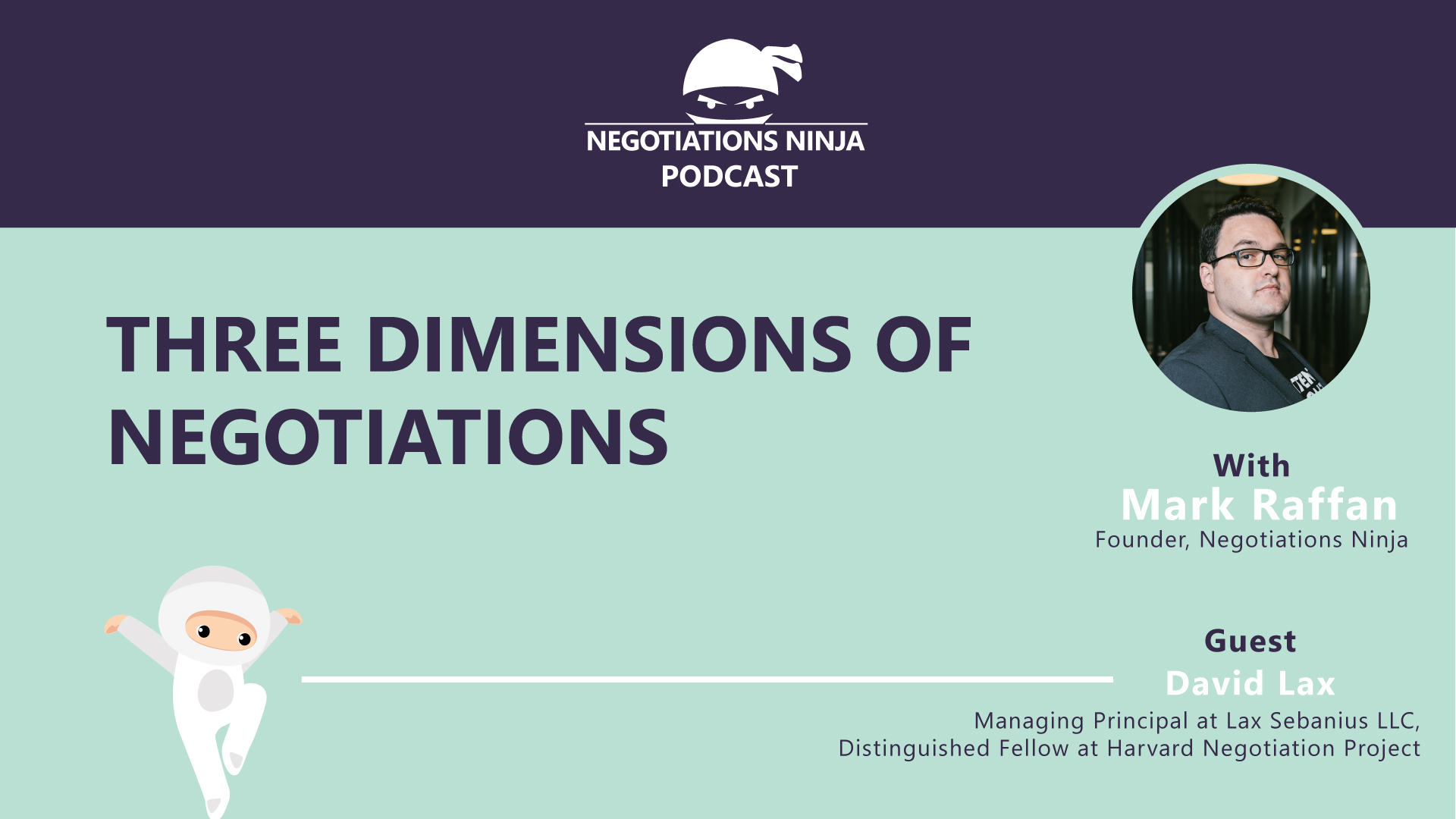This week David Lax—co-author of 3-D Negotiation—joins us. Often negotiators get stuck in the win-win or win-lose debate and focus on face-to-face tactics (the first and second dimensions). What sets the 3-D approach (TM) apart is its “third dimension”. Before showing up at a negotiation, 3-D experts ensure that the right parties have been engaged, in the right sequence, to address the right interests, under the right expectations, and facing the right consequences of walking away if there is no deal.
Often we think of our negotiations—especially if they’re multi-party—in sequential order but that may not necessarily be the most appropriate use of our time. We’re discussing with David how to address this differently. For even more about 3-D Negotiation, check out 3-D Negotiation: Playing the Whole Game by David Lax and James K. Sebenius.
Outline of This Episode
- [2:28] David Lax’s background
- [7:35] What is 3D negotiation?
- [18:35] The concept of “setup”
- [24:42] The right set of interests
- [28:53] Face the right BATNA
- [38:02] How to connect with David
What is 3D negotiation?
People focus on tactics at the table. What do you say? How do you read body language? What is the social and personal psychology involved? That’s just one dimension of negotiation. But you can get more leverage by doing other things.
If David is buying a product and he’s focused on price, you can lower the price and lengthen the delivery date. He’s getting what he wants and you’re getting more time to deliver, which reduces costs. You need to have the right parties, with the right set of interests at stake, the right BATNA, and the sequence of the negotiation right.
If David was selling his company, he’d use better tactics (persuasion, anchoring, etc.) which is the first dimension. He’d create value in the deal by understanding the counterpart’s position and making the deal more tax-efficient (second dimension). Then he can change the setup by adding another buyer (3rd dimension) to negotiate in parallel.
How to think about setup
Who are the parties? How are they related? Who’s affected by the negotiation (and its outcome)? David and his partner James advised a privatized water company in a negotiation with a regulatory body.
Who does the regulator pay attention to? Environmentalists? Legislators? They identified environmentalist groups that would complain to the regulators about them to make them spend more on stormwater and drainage systems. By identifying parties, they got them to go to regulators to pressure for things they thought were good for them.
You go beyond the set of obvious parties to who influences the people in your negotiation. Their client was forced to spend money and get a rate of return on that money. It’s finding external leverage sources.
Who is directly part of the negotiation? Who could influence them? Who are all the players who could be interested in this? Think externally (environmental groups) and internally (lawyers, investment bankers, etc.). You can activate people who wouldn’t have been involved before to create leverage. You have to think creatively about the parties.
Face the right BATNA
Years ago, David and James got a call from a business that made auto parts who wanted to do a joint venture with a company in Mexico. They had ranked the firms they wanted to work with from best to worst. There narrowed it down to three:
- A very technologically advanced and large firm.
- A somewhat smaller firm but close technologically.
- A considerably smaller firm that was less advanced technologically.
They decided to try and make a deal with firm #1. They sent a team to begin negotiating. But the team they sent didn’t speak Spanish and didn’t realize they needed to build a relationship first (at the time). They sent down a mid-level guy, not someone of similar rank to the CEO.
The firm stopped responding to their calls, so they moved to firm #2. This time they hired a cultural coach. They sent in some Spanish speakers and worked on the relationship first. They sent in someone Senior. But over time, firm #2 stopped responding.
Then they called David. After hearing their story, he asked what their BATNA was. Their BATNA was awful because they had blown through their first two options. They had no BATNA, and the 3rd firm knew it. That’s not a position you want to be in.
So what did they do? They scheduled a meeting with firm #3. But they also scheduled a meeting at firm #2 while they were in town. They asked firm #2 for directions to firm #3 (so firm #2 knew they were going there). As they were negotiating with firm #3, firm #2 felt threatened and re-entered the negotiations. When Firm #1 learned about the negotiations, they re-entered.
What could they have done better? David shares the best strategy in this episode. Don’t miss it!
Connect with David Lax
Guest: David Lax
Episode Sponsor
- 2019 SCMA Conference and Awards Gala – 100 Year Celebration
- Discount Code: scma podcast
Connect With Mark
- Follow Negotiations Ninja on Twitter: @NegotiationPod
- Connect with Mark on LinkedIn
- Follow Negotiations Ninja on LinkedIn
- Connect on Instagram: @NegotiationPod




